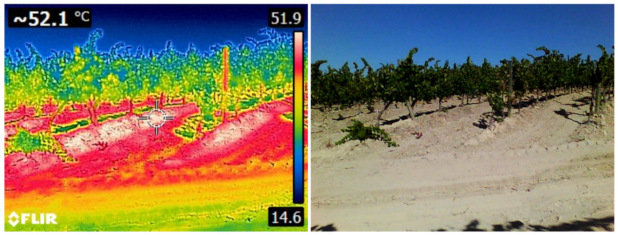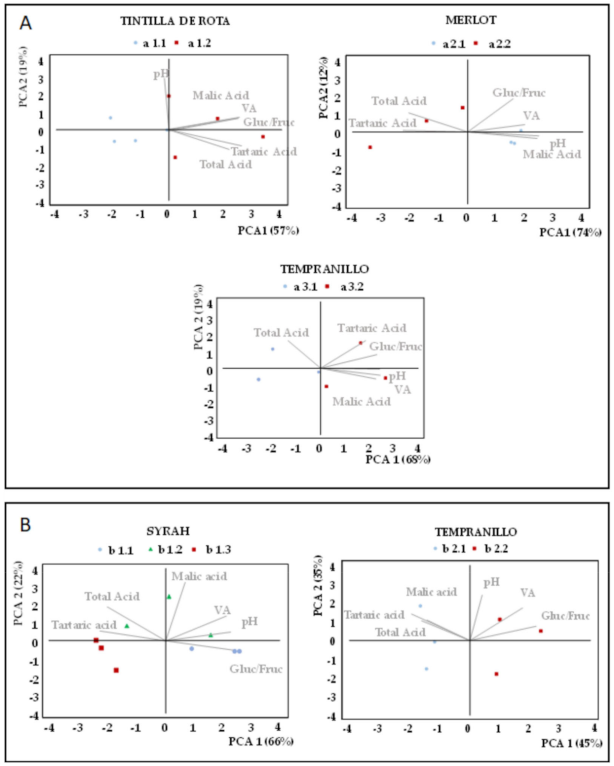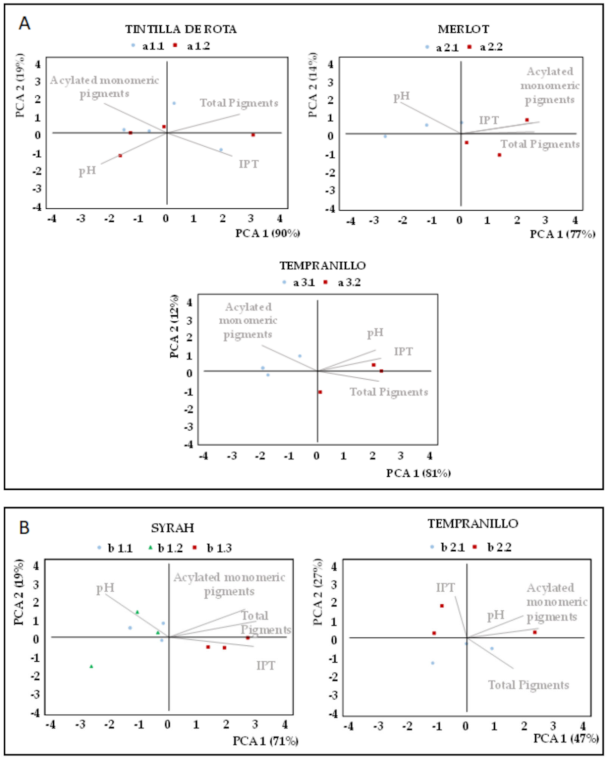The Effect of Elicitors and Canopy Management in the Chemical Composition of Vitis vinifera Red Varieties in Warm and Hot Areas in Spain
Abstract
:1. Introduction
2. Materials and Methods
2.1. Sampling and Vine Monitoring
2.2. Treatments
2.3. Must Composition
2.4. Pigments
2.5. Total Polyphenols Index
2.6. Statistical Analysis
3. Results
3.1. Variations in the Microclimate of Grape Clusters
3.2. Chemical Composition
3.3. Pigments and Phenolic Compounds Accumulation
4. Discussion
5. Conclusions
Author Contributions
Funding
Data Availability Statement
Acknowledgments
Conflicts of Interest
References
- Delaunois, B.; Farace, G.; Jeandet, P.; Clément, C.; Baillieul, F.; Dorey, S.; Cordelier, S. Elicitors as alternative strategy to pesticides in grapevine? Current knowledge on their mode of action from controlled conditions to vineyard. Environ. Sci. Pollut. Res. 2013, 21, 4837–4846. [Google Scholar] [CrossRef] [PubMed]
- Ruíz-García, Y.; Gómez-Plaza, E. Elicitors: A Tool for Improving Fruit Phenolic Content. Agriculture 2012, 3, 33–52. [Google Scholar] [CrossRef] [Green Version]
- Paladines-Quezada, D.F.; Moreno-Olivares, J.D.; Fernández-Fernández, J.I.; Bleda-Sánchez, J.A.; Martínez-Moreno, A.; Gil-Muñoz, R. Elicitors and Pre-Fermentative Cold Maceration: Effects on Polyphenol Concentration in Monastrell Grapes and Wines. Biomolecules 2019, 9, 671. [Google Scholar] [CrossRef] [PubMed] [Green Version]
- Ruiz-García, Y.; Gil-Muñoz, R.; López-Roca, J.M.; Martínez-Cutillas, A.; Romero-Cascales, I.; Gómez-Plaza, E. Increasing the Phenolic Compound Content of Grapes by Preharvest Application of Abcisic Acid and a Combination of Methyl Jasmonate and Benzothiadiazole. J. Agric. Food Chem. 2013, 61, 3978–3983. [Google Scholar] [CrossRef] [PubMed]
- Mazza, G.; Fukumoto, L.; Delaquis, P.; Girard, B.; Ewert, B. Anthocyanins, phenolics and color of Cabernet Franc, Merlot and Pinot Noir wines from British Columbia. J. Agric. Food Chem. 1999, 47, 4009–4017. [Google Scholar] [CrossRef]
- Portu-Reinares, J. Aplicación Foliar de Elicitores y Compuestos Nitrogenados como Estrategia para Mejorar la Composición Fenólica de la Uva y del Vino; Universidad de La Rioja: La Rioja, Spain, 2018. [Google Scholar]
- Iriti, M.; Vitalini, S.; Di-Tommaso, G.; D’Amico, S.; Borgo, M.; Faoro, F. New chitosan formulation prevents grapevine powdery mildew infection and improves polyphenol content snd free radical scavening activity of grape and wine. Aust. J. Grape Wine Res. 2011, 17, 263–269. [Google Scholar] [CrossRef]
- Portu, J.; López, R.; Baroja, E.; Santamaría, P.; Garde-Cerdán, T. Improvement of grape and wine phenolic content by foliar application to grapevine of three different elicitors: Methyl jasmonate, chitosan, and yeast extract. Food Chem. 2016, 201, 213–221. [Google Scholar] [CrossRef]
- Abad, F.J.; Marín, D.; Loidi, M.; Miranda, C.; Royo, J.B.; Urrestarazu, J.; Santesteban, L.G. Evaluation of the incidence of severe trimming on grapevine (Vitis vinifera L.) water consumption. Agric. Water Manag. 2019, 213, 646–653. [Google Scholar] [CrossRef]
- Pérez Recio, G. Operaciones Manuales en Viñedo; Servicio de Formación Agraria e Iniciativas, 2nd ed.; Junta de Castilla y León: Valladolid, Spain, 2009; Volume 2, ISBN 9788469202784. [Google Scholar]
- Da Mota, R.V.; de Souza, C.R.; Silva, C.P.C.; Freitas, G.D.F.; Shiga, T.M.; Purgatto, E.; Lajolo, F.M.; Regina, M.D.A. Biochemical and agronomical responses of grapevines to alteration of source-sink ratio by cluster thinning and shoot trimming. Bragantia 2010, 69, 17–25. [Google Scholar] [CrossRef] [Green Version]
- Spayd, S.E.; Tarara, J.M.; Mee, D.L.; Ferguson, J.C. Separation of sunlight and temperature effects on the composition of Vitis vinifera cv. Merlot berries. Am. J. Enol. Vitic. 2002, 53, 171–182. [Google Scholar]
- Verschuuren, J. The Paris Agreement on Climate Change: Agriculture and food security. Eur. J. Risk Regul. 2016, 7, 54–57. [Google Scholar] [CrossRef] [Green Version]
- Ali, S.; Liu, Y.; Ishaq, M.; Shah, T.; Abdullah Ilyas, A.; Din, I. Climate Change and Its Impact on the Yield of Major Food Crops: Evidence from Pakistan. Foods 2017, 6, 39. [Google Scholar] [CrossRef]
- Johnson, H.; Robinson, J. The World Atlas of Wine, 7th ed.; Beazley, M., Ed.; Octopus Publishing Group: London, UK, 2013; ISBN 978184330899. [Google Scholar]
- Abeysinghe, S.; Greer, D.; Rogiers, S. The effect of light intensity and temperature on berry growth and sugar accumulation in “Vitis vinifera” ‘Shiraz’ under vineyard conditions. Vitis J. Grapevine Res. 2019, 58, 7–16. [Google Scholar]
- Parker, A.K.; García de Cortázar-Atauri, I.; Gény, L.; Spring, J.L.; Destrac, A.; Schultz, H.; Molitor, D.; Lacombe, T.; Graça, A.; Monamy, C.; et al. Temperature-based grapevine sugar ripeness modelling for a wide range of Vitis vinifera L. cultivars. Agric. For. Meteorol. 2020, 285–286, 107902–107915. [Google Scholar] [CrossRef]
- Loira, I.; Morata, A.; González, C.; Suárez-Lepe, J.A. Selection of Glycolytically Inefficient Yeasts for Reducing the Alcohol Content of Wines from Hot Regions. Food Bioprocess. Technol. 2012, 5, 2787–2796. [Google Scholar] [CrossRef]
- Rodríguez Montealegre, R.; Romero Peces, R.; Chacón Vozmediano, J.L.; Martínez Gascueña, J.; García Romero, E. Phenolic compounds in skins and seeds of ten grape Vitis vinifera varieties grown in a warm climate. J. Food Compos. Anal. 2006, 19, 687–693. [Google Scholar] [CrossRef]
- Teixeira, A.; Eiras-Días, J.; Castellarin, S.D.; Gerós, H. Berry phenolics of grapevine under challenging environments. Int. J. Mol. Sci. 2013, 14, 18711–18739. [Google Scholar] [CrossRef] [Green Version]
- Agencia Estatal de Meteorología. Available online: http://www.aemet.es/es/serviciosclimaticos/vigilancia_clima/resumenes?w=1&k=and (accessed on 29 May 2020).
- Escott, C.; Del Fresno, J.M.; Loira, I.; Morata, A.; Tesfaye, W.; González, C.; Suárez-Lepe, J.A. Formation of polymeric pigments in red wines through sequential fermentation of flavanol-enriched musts with non-Saccharomyces yeasts. Food Chem. 2018, 239, 975–983. [Google Scholar] [CrossRef]
- Tsiakkas, O.; Escott, C.; Loira, I.; Morata, A.; Rauhut, D.; Suárez-Lepe, J.A. Determination of Anthocyanin and Volatile Profile of Wines from Varieties Yiannoudi and Maratheftiko from the Island of Cyprus. Beverages 2020, 6, 4. [Google Scholar] [CrossRef] [Green Version]
- He, F.; Liang, N.-N.; Mu, L.; Pan, Q.-H.; Wang, J.; Reeves, M.J.; Duan, C.-Q.; He, F.; Liang, N.-N.; Mu, L.; et al. Anthocyanins and their variation in red wines I. Monomeric anthocyanins and their color expression. Molecules 2012, 17, 1571–1601. [Google Scholar] [CrossRef] [Green Version]
- Escott, C.; Morata, A.; Zamora, F.; Loira, I.; del Fresno, J.M.; Suárez-Lepe, J.A. Study of the interaction of anthocyanins with phenolic aldehydes in a model wine solution. ACS Omega 2018, 3, 15575–15581. [Google Scholar] [CrossRef] [PubMed]
- Du, F.; Deng, W.; Yang, M.; Wang, H.; Mao, R.; Shao, J.; Fan, J.; Chen, Y.; Fu, Y.; Li, C.; et al. Protecting grapevines from rainfall in rainy conditions reduces disease severity and enhances profitability. Crop. Prot. 2015, 67, 261–268. [Google Scholar] [CrossRef]
- Smith, J.P.; Edwards, E.J.; Walker, A.R.; Gouot, J.C.; Barril, C.; Holzapfel, B.P. A whole canopy gas exchange system for the targeted manipulation of grapevine source-sink relations using sub-ambient CO2. BMC Plant Biol. 2019, 19, 535. [Google Scholar] [CrossRef] [PubMed] [Green Version]
- Coetzee, Z.A.; Walker, R.R.; Deloire, A.; Clarke, S.J.; Barril, C.; Rogiers, S.Y. Spatiotemporal changes in the accumulation of sugar and potassium within individual “Sauvignon Blanc” (Vitis vinifera L.) berries. Vitis 2017, 56, 189–195. [Google Scholar]
- Brillante, L.; Martínez-Lüscher, J.; Kaan Kurtural, S. Applied water and mechanical canopy management affect berry and wine phenolic and aroma composition of grapevine (Vitis vinifera L., cv. Syrah) in Central California. Sci. Hortic. 2018, 227, 261–271. [Google Scholar] [CrossRef]
- Reshef, N.; Walbaum, N.; Agam, N.; Fait, A. Sunlight Modulates Fruit Metabolic Profile and Shapes the Spatial Pattern of Compound Accumulation within the Grape Cluster. Front. Plant. Sci. 2017, 8, 70–90. [Google Scholar] [CrossRef] [Green Version]
- Figueiredo-González, M.; Cancho-Grande, B.; Simal-Gándara, J. Garnacha Tintorera-based sweet wines: Chromatic properties and global phenolic composition by means of UV-Vis spectrophotometry. Food Chem. 2013, 140, 217–224. [Google Scholar] [CrossRef]
- Schwarz, M.; Hofmann, G.; Winterhalter, P. Investigations on anthocyanins in wines from Vitis vinifera cv. pinotage: Factors influencing the formation of pinotin A and its correlation with wine age. J. Agric. Food Chem. 2004, 52, 498–504. [Google Scholar] [CrossRef]
- Burdziej, A.; Da Costa, G.; Gougeon, L.; Le Mao, I.; Bellée, A.; Corio-Costet, M.-F.; Mérillon, J.-M.; Richard, T.; Szakiel, A.; Cluzet, S. Impact of different elicitors on grapevine leaf metabolism monitored by 1H NMR spectroscopy. Metabolomics 2019, 15, 1–11. [Google Scholar] [CrossRef]
- Moreno-Delafuente, A.; Garzo, E.; Fereres, A.; Viñuela, E.; Medina, P. Effects of a Salicylic Acid Analog on Aphis gossypii and Its Predator Chrysoperla carnea on Melon Plants. Agronomy 2020, 10, 1830. [Google Scholar] [CrossRef]
- Miclea, I.; Suhani, A.; Zahan, M.; Bunea, A. Effect of Jasmonic Acid and Salicylic Acid on Growth and Biochemical Composition of In-Vitro-Propagated Lavandula angustifolia Mill. Agronomy 2020, 10, 1722. [Google Scholar] [CrossRef]
- Król, A.; Amarowicz, R.; Weidner, S. Changes in the composition of phenolic compounds and antioxidant properties of grapevine roots and leaves (Vitis vinifera L.) under continuous of long-term drought stress. Acta Physiol. Plant. 2014, 36, 1491–1499. [Google Scholar] [CrossRef] [Green Version]
- Park, W.T.; Arasu, M.V.; Al-Dhabi, N.A.; Yeo, S.K.; Jeon, J.; Park, J.S.; Lee, S.Y.; Park, S.U. Yeast extract and silver nitrate induce the expression of phenylpropanoid biosynthetic genes and induce the accumulation of rosmarinic acid in agastache rugosa cell culture. Molecules 2016, 21, 426. [Google Scholar] [CrossRef]
- Dixon, R.A.; Achnine, L.; Kota, P.; Liu, C.-J.; Reddy, M.S.S.; Wang, L. The phenylpropanoid pathway and plant defence—A genomics perspective. Mol. Plant. Pathol. 2002, 3, 371–390. [Google Scholar] [CrossRef]
- Hanlin, R.L.; Hrmova, M.; Harbertson, J.F.; Downey, M.O. Review: Condensed tannin and grape cell wall interactions and their impact on tannin extractability into wine. Aust. J. Grape Wine Res. 2010, 16, 173–188. [Google Scholar] [CrossRef]
- Zhang, Z.; Zou, L.; Ren, C.; Ren, F.; Wang, Y.; Fan, P.; Li, S.; Liang, Z. VvSWEET10 Mediates Sugar Accumulation in Grapes. Genes 2019, 10, 255. [Google Scholar] [CrossRef] [PubMed] [Green Version]





| DOP | Variety | Elevation (m) | Temp H/S (°C) | Treatment | No. Blocks | ID |
|---|---|---|---|---|---|---|
| Test a—Elicitors | ||||||
| Vino de la Tierra de Cádiz | Tintilla de Rota | 118 | 20.6/21.7 | Control | 4 | a1.1 |
| Elicitors | 4 | a1.2 | ||||
| La Mancha | Merlot | 670 | 19.5/21.7 | Control | 3 | a2.1 |
| Elicitors | 3 | a2.2 | ||||
| Ribera del Duero | Tempranillo | 801 | 16.3/16.9 | Control | 3 | a3.1 |
| Elicitors | 3 | a3.2 | ||||
| Test b—Canopy management | ||||||
| Vino de la Tierra de Cádiz | Syrah | 110 | 20.6/21.7 | Control | 3 | b1.1 |
| Shoot trimmin 1 | 3 | b1.2 | ||||
| Shoot trimming 2 | 3 | b1.3 | ||||
| Uclés | Tempranillo | 746 | 18.2/19.2 | Control | 3 | b2.1 |
| Sprawl system | 3 | b2.2 | ||||
| ID | Sugars | pH | Malic Acid | Tartaric Acid | α Amino | Ammonia | Gluconic Acid | Volatile Acidity |
|---|---|---|---|---|---|---|---|---|
| g/L | g/L | g/L | g/L | g/L | g/L | g/L | ||
| Test a—Elicitors | ||||||||
| a 1.1 | 238.4 ± 1.6 a | 3.4 ± 0.0 a | 1.3 ± 0.1 a | 5.7 ± 0.9 a | 123.2 ± 12.6 a | 66.1 ± 2.0 a | 0.9 ± 0.1 a | 0.1 ± 0.0 a |
| a 1.2 | 234.1 ± 2.2 b | 3.4 ± 0.0 a | 1.1 ± 0.1 b | 4.2 ± 0.8 b | 113.7 ± 5.8 a | 39.6 ± 9.4 b | 0.7 ± 0.2 a | 0.1 ± 0.0 a |
| a 2.1 | 268.2 ± 2.4 a | 4.2 ± 0.0 a | 1.7 ± 0.0 a | 4.5 ± 0.1 a | 192.3 ± 12.0 a | 81.2 ± 13.3 a | 1.7 ± 0.3 a | 0.2 ± 0.0 a |
| a 2.2 | 266.9 ± 4.3 a | 4.1 ± 0.0 b | 1.5 ± 0.1 b | 4.7 ± 0.1 a | 179.7 ± 7.8 a | 78.2 ± 4.2 a | 1.6 ± 0.2 a | 0.2 ± 0.0 a |
| a 3.1 | 221.3 ± 7.9 a | 4.1 ± 0.1 a | 2.6 ± 0.2 b | 6.0 ± 0.5 a | 232.2 ± 57.1 a | 114.9 ± 11.7 a | 0.2 ± 0.4 a | 0.1 ± 0.0 b |
| a 3.2 | 232.5 ± 3.6 a | 4.2 ± 0.1 a | 3.4 ± 0.2 a | 6.4 ± 0.5 a | 303.6 ± 91.0 a | 161.5 ± 44.0 a | 0.5 ± 0.2 a | 0.1 ± 0.0 a |
| Test b—Canopy management | ||||||||
| b 1.1 | 262.0 ± 6.2 a | 3.7 ± 0.1 a | 1.9 ± 0.1 a b | 2.7 ± 0.2 c | 142.6 ± 11.5 a | 69.6 ± 3.1 a | 1.0 ± 0.4 a | 0.1 ± 0.0 a |
| b 1.2 | 236.9 ± 10.4 b | 3.7 ± 0.1 a | 2.3 ± 0.4 a | 5.6 ± 0.5 b | 149.5 ± 5.1 a | 70.6 ± 2.6 a | 0.6 ± 0.1 a | 0.1 ± 0.0 a |
| b 1.3 | 228.3 ± 3.2 b | 3.6 ± 0.4 b | 1.7 ± 0.1 b | 7.2 ± 1.1 a | 141.5 ± 27.2 a | 76.8 ± 35.5 a | 1.0 ± 0.1 a | 0.1 ± 0.0 a |
| b 2.1 | 237.4 ± 5.1 b | 4.2 ± 0.1 a | 2.8 ± 0.2 a | 4.7 ± 0.6 a | 201.6 ± 18.8 a | 69.73 ± 7.5 a | 1.3 ± 0.3 a | 0.2 ± 0.0 a |
| b 2.2 | 256.4 ± 9.3 a | 4.2 ± 0.1 a | 2.6 ± 0.2 a | 3.7 ± 0.3 a | 215.1 ± 24.5 a | 77.3 ± 30.9 a | 1.7 ± 0.3 a | 0.2 ± 0.0 a |
| ID | Total Pigments | Acylated Monomeric Pigments | IPT | pH |
|---|---|---|---|---|
| Test a—Elicitors | ||||
| a 1.1 | 198.7 ± 10.2 a | 25.6 ± 1.8 a | 12.8 ± 0.8 a | 3.4 ± 0.0 a |
| a 1.2 | 191.8 ± 21.0 a | 25.1 ± 2.0 a | 13.1 ± 0.6 a | 3.4 ± 0.0 a |
| a 2.1 | 233.4 ± 28.8 a | 111.4 ± 17.3 a | 8.9 ± 1.5 a | 4.1 ± 0.0 a |
| a 2.2 | 201.5 ± 27.3 a | 82.5 ± 21.8 a | 7.0 ± 1.9 a | 4.2 ± 0.1 a |
| a 3.1 | 491.2 ± 14.1 a | 91.8 ± 4.6 a | 25.4 ± 0.8 a | 4.1 ± 0.1 a |
| a 3.2 | 582.4 ± 86.4 a | 108.6 ± 20.8 a | 28.4 ± 2.4 a | 4.2 ± 0.1 a |
| Test b—Canopy management | ||||
| b 1.1 | 179.4 ± 13.0 ab | 87.1 ± 1.6 a | 12.2 ± 0.9 b | 3.7 ± 0.1 a |
| b 1.2 | 160.6 ± 6.7 b | 84.3 ± 9.9 a | 11.0 ± 1.6 b | 3.7 ± 0.0 a |
| b 1.3 | 205.8 ± 22.1 a | 95.8 ± 13.2 a | 16.8 ± 1.3 a | 3.6 ± 0.1 a |
| b 2.1 | 248.7 ± 15.5 a | 69.8 ± 4.7 a | 8.0 ± 0.7 b | 4.2 ± 0.1 a |
| b 2.2 | 245.3 ± 36.2 a | 74.1 ± 9.8 a | 13.5 ± 1.1 a | 4,.2 ± 0.1 a |
Publisher’s Note: MDPI stays neutral with regard to jurisdictional claims in published maps and institutional affiliations. |
© 2021 by the authors. Licensee MDPI, Basel, Switzerland. This article is an open access article distributed under the terms and conditions of the Creative Commons Attribution (CC BY) license (https://creativecommons.org/licenses/by/4.0/).
Share and Cite
Gutiérrez, N.; López-de-Silanes, L.; Escott, C.; Loira, I.; del Fresno, J.M.; Suárez-Lepe, J.A.; Morata, A. The Effect of Elicitors and Canopy Management in the Chemical Composition of Vitis vinifera Red Varieties in Warm and Hot Areas in Spain. Agronomy 2021, 11, 1192. https://doi.org/10.3390/agronomy11061192
Gutiérrez N, López-de-Silanes L, Escott C, Loira I, del Fresno JM, Suárez-Lepe JA, Morata A. The Effect of Elicitors and Canopy Management in the Chemical Composition of Vitis vinifera Red Varieties in Warm and Hot Areas in Spain. Agronomy. 2021; 11(6):1192. https://doi.org/10.3390/agronomy11061192
Chicago/Turabian StyleGutiérrez, Natalia, Leyre López-de-Silanes, Carlos Escott, Iris Loira, Juan Manuel del Fresno, José Antonio Suárez-Lepe, and Antonio Morata. 2021. "The Effect of Elicitors and Canopy Management in the Chemical Composition of Vitis vinifera Red Varieties in Warm and Hot Areas in Spain" Agronomy 11, no. 6: 1192. https://doi.org/10.3390/agronomy11061192








